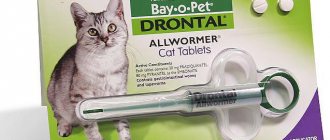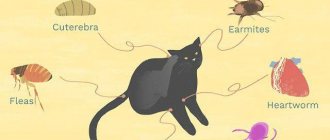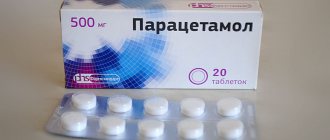Helminthiasis is a common disease that is often diagnosed in animals, including cats that are susceptible to infection with parasites. Contrary to the popular belief that helminthiasis occurs only in street cats or pets that often walk outside, the disease also occurs in pets that have never left the house. The larvae can enter the cat's body along with poor-quality food, as a result of insufficient heat treatment; they can be brought indoors along with dirt on shoes or hands. Despite the apparent non-seriousness of the disease, helminthiasis can cause serious damage to internal organs and even cause death. In order not to bring your animal to a critical condition, it is better to find out in advance what is best to give your cat for worms, whether there are tablets to prevent worms in cats, and how to recognize that your pet is sick.
How often should anthelmintics be used for dogs and cats?
1.
According to the WSAVA, dogs and cats are best dewormed quarterly.
2.
If your region is unfavorable for dirofilariasis, then during the flight of mosquitoes, monthly medications are used to prevent this disease (Stronghold, Advocate, Milbemax, etc.). It is possible to replace them with prolonged macrocyclic lactones, but we do not sell them yet.
3.
If the dog is a herding dog, then deworming with praziquantel-containing drugs once a month is advisable. (This figure has been confirmed many times in experiments). This is a matter of the safety of the health of the surrounding people and the herd, and not the health of the dog itself.
4.
Indoor cats, if they follow a diet without raw fish, products of slaughterhouse origin, mice and there are no walking animals (for example, dogs) in the house or other sources of fleas, can be dewormed once every 6 months. (this is my personal opinion), and sometimes even less often. This applies to adult animals, i.e. older than 8-12 months. This provision does not apply to puppies and kittens.
In this case, we are talking about “blind” prevention, when you do not know whether the animal is infected or not. If there is a specific diagnosis or a specific parasitological situation, then the frequency and drugs are selected individually.
Is it possible to prevent helminthiasis infection?
To minimize the risk of infection for your pet, you should adhere to the following rules:
- avoid contact with infected animals;
- carry out preventive treatment against ticks and fleas in a timely manner;
- do not feed raw fish and meat, give preference to balanced ready-made food;
- Give deworming medication to cats regularly as a preventive measure.
Veterinarians strongly do not recommend giving animals untested drugs or using folk remedies with unproven effectiveness.
Should owners take prophylactic anthelmintic drugs, such as Decaris?
As for humans, I categorically do not recommend taking medications for prevention. Moreover, “Dekaris”, which can stimulate the immune system, or, when taken repeatedly, cause agranulocytosis (a serious problem with hematopoiesis), which is by no means uncommon. The best prevention of helminthiases is hygiene and nutrition, not pills. This makes us radically different from dogs and cats. If a person has complaints, it is necessary to consult a doctor, undergo diagnosis and treatment. The attitude towards parasites is often determined not by their real danger, which I, of course, do not dispute, but by the fact that they are visible and they are “disgusting”. No one takes antibiotics to prevent leptospirosis, “slow” infections, etc. If you have no complaints: take a standard screening test (“for worm eggs”). There are complaints: get tested according to the complaints. The presence of complaints is what distinguishes us from silent patients - animals.
Tablets for cats from worms
The tablet form is convenient for storage and transportation, but not all animals are happy to take the entire medicine. To simplify the process, you can use an introducer, mix the tablet with food, or grind the drug into powder.
Effective tablets for cats against worms:
- Drontal;
- Cestal Cat;
- Milbemax;
- Azinox;
- Gelmimax-4;
- Milprazone;
- Dirofen;
- Dironet;
- Febtal;
- Celandine Antihelmintic;
- Dehinel;
- Alben S;
- Helmintal T;
- Milbemax..
Does it make sense to deworm children who are constantly in contact with dogs and cats?
I don’t see the point in prophylactically deworming children like dogs and cats. Although in some areas I would do just that J. Dekaris has already been mentioned above, another option is albendazole. It should be noted that this is a very dangerous thing and the consequences of its use can be disastrous. Compared to some banal pinworms or creepy-looking roundworms, albendazole can sometimes be the worst evil if it is used unreasonably - “blindly”. If we are going to conduct “experiments” on children, then let’s say using some pyrantel or piperazine, for example, because To become infected with cestodes, you still have to try, and as a rule, this is not done with the help of dirty hands. It is worth getting tested and not neglecting hygiene and teaching it. But at the same time, as with any parasitological diagnostic method, you can believe the positive result and take action, and not relax if the result is negative.
Contraindications and side effects
Anti-worm drops for cats have certain contraindications for use:
- the kitten is under 2 months old;
- period of pregnancy or lactation - for most drugs;
- infections and viruses in cats;
- exhaustion, weakened immunity after illness;
- individual intolerance to the components of the drug.
In rare cases, unwanted side reactions are possible, which are expressed by the following symptoms:
- digestive upset, nausea and vomiting;
- lacrimation and salivation;
- allergic skin rash;
- cramps and muscle spasms.
Before using any deworming drops on the withers for cats, it is recommended to consult a veterinarian. To be sure of the quality and authenticity of the product, it is better to purchase medications in specialized stores or veterinary clinics.
Can worms develop resistance to anthelmintics?
There are several proven cases of resistance: piperazine has stopped working. Over several decades, its therapeutic doses for dogs and cats have increased and merged with toxic ones. There are strains of hookworms resistant to pyrantel. For the most part, resistance is passed off as the known fact that drugs are not 100% effective, or other errors - diagnostics, drug selection. When the manufacturer, without blinking an eye, tells you about the resistance of helminths, about the need to alternate medications, as in the story about antibiotics, he is, to put it mildly, disingenuous. In horses and cattle, resistance to some drugs can indeed be a problem.
Is there a danger to humans? Probability of infection
About 32 varieties of worms can live in a cat’s body, which pose a danger to human health. The main cause of infection is non-compliance with hygiene rules. When feeding a cat by hand or playing with it, parasite eggs land on the skin of the hands and then penetrate into the oral cavity.
In addition, worms can enter the human body by touching surfaces on which eggs remain (for example, a tray).
The danger of infection with worms for humans (without proper treatment):
- enterobiasis,
- Iron-deficiency anemia,
- dyspeptic disorders (heartburn, diarrhea, etc.),
- damage to internal organs, etc.
To avoid dangerous consequences, it is necessary to regularly examine your pet, and if the first signs of helminthiasis occur, seek veterinary help. The specialist will conduct a thorough diagnosis of the cat’s condition and tell you whether they are dangerous to the human body.
Does a puppy need to be dewormed monthly until he is one year old?
It depends on what. If we are talking about pyrantel compounds, then for up to 3 months with toxocariasis, you will have to deworm it even more often - every 2 weeks, then monthly, and so on until 6-8 months of age, depending on the regimen.
The fact is that drugs containing pyrantel (and the vast majority of them on the Russian market) act exclusively in the intestinal lumen, and primarily against helminths such as Toxocara, Hookworm and Toxascaris. We are not talking about others, because... they are less common. The development cycle of the same Toxocara provides for it to migrate from the intestine through the liver and lungs, after which it enters the intestine, where it becomes an adult. So, pyrantel acts on adults, but does not affect migrating larvae. The drug itself remains in therapeutic doses in the body for approximately the same amount of time as the food that entered the body, i.e. within 12 hours. After 12 hours, the drug leaves the body and the animal is again ready for infection. Moreover, within a couple of hours after the drug is excreted, dozens of larvae that have completed their migration may enter the intestine. In just 5 days they will lay eggs and the control test will be positive, as if nothing had happened. Therefore, puppies and kittens are dewormed as often as possible when it comes to the use of pyrantel-containing drugs. As mentioned above - for the smallest puppies every 14 days, for kittens every 21 days.
As the animal matures, the success of full migration of Toxocara larvae in dogs decreases. Therefore, animals are dewormed less and less often. Adult dogs (over 8-12 months) practically do not support the complete migration of Toxocara, so they are rarely dewormed - at 3 months.
Common medications
Commonly used tablets for deworming in cats:
- "Drontal" - tablets weighing 350 grams. Drontal is a broad-spectrum drug. This medicine is effective against many types of worms. 350 grams of the drug is designed for an adult animal weighing over 4 kilograms. Prohibited for kittens and pregnant cats.
- Kanikquantel is a tablet prescribed for an adult animal. Use according to instructions, usually the cat is given half a tablet.
- Milbemax. Available separately for adult animals and for kittens.
Drops:
- Profender - anthelmintic drops applied to the withers of the animal. Suitable for both adult cats and two-month-old kittens. The pet should not reach the drops applied to the skin with the tongue, otherwise increased salivation may develop, leading to vomiting.
- Stronghold – drops produced in pipettes, which can also be applied to the pet’s withers.
Suspension:
- Prazicide destroys worms at any stage of their development. Using a dispenser syringe, the cat is given medication on the root of the tongue so that it can swallow it more easily.
Sugar cubes:
- Polyvercan is a French broad-spectrum drug. It quickly dissolves in water, tastes good and is easily drunk by your pet.
How do you recommend deworming puppies, if not pyrantel, and how often?
If a puppy is without fleas and does not go outside yet, then his mother and himself should be treated with, say, “Advocate”, “Stronghold” - this solves the problem of toxocara well. It is necessary to take into account age restrictions and whether his mother is feeding him milk. This treatment should be done once a month. If your wallet doesn’t allow it, ivermectin is given orally or injected to the entire litter (don’t forget about the age restrictions!). Milbemax is somewhat less effective, but it can be used from a very early age. It is better to use drugs containing pyrantel with adults who are not pregnant (male dogs, for example) precisely for prevention - it is convenient, cheap and highly safe.
For selections in shelter conditions, you have to choose cheaper schemes. If a puppy or kitten is picked up from the street, the first deworming should not be carried out immediately when the animal gets home, in the very first days. It is best to fatten him first, give him vitamins, then something containing pyrantel, and then ivermectin.
Signs of helminthiasis
In the initial stage, helminth infection may be asymptomatic. Symptoms increase as the number of parasites increases; clinical manifestations depend on the type of worm, and the speed of their development depends on the age and weight of the animal.
Main symptoms:
- diarrhea or difficulty defecating;
- vomiting and other gastrointestinal disorders;
- blood and mucus may be present in the stool;
- the animal experiences itching in the anal area, which is quickly eliminated with deworming medications for cats;
- upon closer examination, worms or white larvae can be seen on the mucous membrane under the tail;
- if a remedy for worms for a cat is not prescribed in the near future, the pet’s belly swells and takes on a rounded shape;
- body weight is rapidly decreasing;
- loss of appetite;
- the animal sheds profusely, the quality of the coat deteriorates;
- there are breathing problems, a cough may be present;
- the pet gets tired quickly and prefers not to get up again;
- the mucous membrane becomes pale.
If a pregnant cat is infected with helminths, the risk of premature delivery increases. In addition, after giving birth, you will need a dewormer for kittens to prevent the condition of the newly born babies from worsening.
What can a dog become infected with when fed (raw) meat? And how can this be dangerous for humans?
By the word “meat” I mean, first of all, products of slaughterhouse origin, this includes pure meat, liver, and lungs. The fact is that, as a rule, if an animal is fed raw meat, then it is probably fed the rest. In general, you can specifically ask the owner about each type of product, but I don’t see much point in this.
The meat may contain Toxocara larvae, less commonly cestode larvae. Trichinosis is not of great importance for cats and dogs, and with trichinosis everything is more or less in order in terms of examination - pigs are checked, but cows and sheep do not need this. Since we cannot be completely confident in the quality assessment of the meat we purchase, the dog should receive its dose of praziquantel once every 3 months, regardless of whether it is urban or not.
From products of slaughterhouse origin you can get a complete set:
- from pigs - echinococcosis, alveococcosis, taeniasis;
- from cattle – echinococcosis, teniosis;
- from sheep - muscular coenurosis (dogs), echinococcosis, extremely rarely (!) alveococcosis (cats and dogs), teniasis;
- rabbits - alveococcosis, teniosis;
- And also linguatulosis, toxocariasis, etc....
Actually, when they came up with preventive deworming, it was aimed specifically at these “comrades”, because a person becomes an intermediate host, receiving the invasive origin from his animals - predators, which are usually the final hosts. A dog should receive its dose of praziquantel every 3 months, regardless of whether it is a city dweller or not.
. Echinococcosis and alveococcosis are diseases that are controlled by WHO and WSAVA.
What to look for when choosing an anthelmintic
Anthelmintic drugs for cats vary according to many criteria - from manufacturer to price. But the following factors become decisive, so you should focus on them when choosing an anthelmintic.
Who is the drug intended for?
It is important that among the “target” animals (those for whom this remedy is suitable) cats are listed. This is due to the fact that the active substances, their therapeutic concentration, frequency of administration, etc. are selected for a certain type of metabolism and other characteristics of the body. Accordingly, an anthelmintic, for example, for birds, farm animals or reptiles will not be suitable for a cat, nor vice versa.
Composition of the drug
If the animal has an allergy or individual intolerance to any medicinal substances, it is important to take this into account when choosing an anthelmintic. If, from previous experience, you already know that your pet reacts “ambiguously” to a certain drug, then the next time you prevent or treat helminthiasis, you should choose a product with a different active ingredient. Attention! You need to pay attention specifically to the active substance, and not to the commercial name of the drug.
Age of the cat
Although dewormers for cats over a year old and young kittens often use the same substances, the dosages may differ. As a rule, it is easier to give a liquid suspension to small kittens. It is easy to dose, and if the kitten is very small, less than 1 kg, the suspension is easy to dilute. If you give an “adult” tablet to a kitten, this will have a bad effect on its health, since the dose of the active substance may be too high.
Release form of the drug
It is not enough to know how to properly administer anthelmintic medication to a cat. She needs to “agree” to accept him. Some pets calmly tolerate this procedure, others may show serious resistance, and still others are able to remain in a state of stress for several days after being forced to take the pill and not leave the shelter. For the last two categories of animals, it is better to choose the most “calm” form of release, for example, drops on the withers. This will allow for high-quality treatment against worms and not injure the cat. Also, drops on the withers or suspensions against helminths are best chosen for pets with “increased ingenuity.” Some cats outright refuse the pills or cough them up a few minutes after swallowing them.
Veterinarian's recommendations
This is one of the most important points when choosing an anthelmintic. It is especially relevant if:
- you picked up an animal and don’t know its age;
- the cat is about to undergo its first deworming;
- previous treatment for worms was ineffective or the animal experienced undesirable reactions to the drug;
- the cat is weakened after an illness or is underweight;
- the animal has any chronic diseases;
- the cat is pregnant or nursing kittens.
After examining your pet and, if necessary, performing routine tests, the doctor will choose the most appropriate deworming drug.
This will allow you to be sure that the chosen medicine has passed clinical trials, is approved for use in veterinary practice and is safe for cats. These drugs include anthelmintics for AVZ.
What do you think about the drug "Profender"?
Most owners think that tablets are a priori better, because... worms in the intestines, the tablet is sent there. “Profender” has been tested on hundreds of cats, starting with my own cat. There were several cases of misfires - this is acceptable because Any even super drug works with about 99% efficiency.
This drug is absorbed from the skin into the blood and kills Toxocara larvae, and then excreted with bile into the intestines and kills adults there. When using the drug, dead helminths will be excreted in the feces 2-3 days after using the drug. Those who use pyrantel are accustomed to the fact that helminths come out within the first day, and without waiting for the effect, they sometimes go to the store for a pill.
Anthelmintics for cats - which ones are better?
To get a competent answer to the question of what tablets to give your cat against worms, you need to seek help from a veterinarian. To select a drug and calculate the dose, you need to take into account the pet’s age, weight and health condition. Doctors recommend purchasing a wide range of anthelmintic drugs for cats and simultaneously treating them against external ectoparasites. It is strictly forbidden to give an animal several medications at once, this can lead to an overdose. Anthelmintic for cats is available in different forms, these can be tablets, syrups, suspensions or drops.
What is the difference between toxocariasis and toxascariasis?
Toxocariasis has a number of differences with toxascariasis:
- Toxocariasis is capable of migration through the lungs, which means toxocariasis is a diagnosis that can explain cough in some cases;
- Toxocariasis is transmitted through mother's milk and in utero;
- Toxocariasis is more difficult to treat due to its migratory stages;
- Dog toxocariasis is dangerous to humans, and the danger of toxascarides to humans has not been definitively established.
If you determine the parasite to species in this case, you can clearly state whether it is dangerous for humans. You can clearly state that in this case it is better to use ivermectin, and pyrantel will not do.
Diagnostics
The first stage of treatment is the diagnosis of helminthiasis. It is aimed at determining the type of parasites, since further treatment depends on their characteristics. In a veterinary clinic, various methods are used to diagnose helminthiasis.
Among them:
- stool analysis,
- sputum analysis,
- X-ray examination of the thoracic region,
- ultrasonography,
- blood analysis.
After diagnosis, a course of treatment and specific medications are prescribed, aimed at destroying and removing parasites from the animal’s body, as well as relieving symptoms that arise.
How do you feel about the drug "Troncil"?
Trontsil is a drug that acts only in the intestinal lumen. Therefore, after 12 hours, the larvae, on which pyrantel has no effect, will be expectorated, swallowed and will end up in the intestines ready to lay eggs within a few days.
What fish can you become infected with opisthorchiasis by eating? Can sea fish, when they come from spawning and are in fresh water, be infected with opisthorchiasis at this time?
Only the carp family - crucian carp, bream, roach, roach, verkhovka, rarely carp itself, ide, plus minnow and gudgeon can become infected with opisthorchiasis. Saltwater fish cannot and river trout cannot. Marine fish cannot even become infected experimentally, because the cercariae emerging from the bithinia are sensitive to salinity, just like the bithinia themselves. They are weak, gentle creatures. But trout and salmon, as well as some other marine and migratory fish, become infected with diphyllobothriasis! In addition to the common tapeworm, there are also many species that can live in the intestines of humans and animals and are transmitted by marine fish. Therefore, there is no need to relax. Freshwater trout, pike, burbot, perch, loach, sterlet, and sturgeon are not infected with opisthorchiasis. And I don’t even immediately remember carp fish that would go from the sea to the river to spawn. Sea crucian carp and perch are not carp. I remembered only one type of fish that would enter rivers from the sea and could become infected with opisthorchiasis - roach.
Anthelmintic drops for cats
Preparations in the form of drops are used for external treatment of the animal and are used to combat external and internal parasites. Among other advantages, it should be noted that you do not have to forcibly restrain the animal to apply the drug. Effective drops for cats against worms and parasites:
- Helmintal K Spot-On;
- Profender.
Determine which deworming medicine for cats is suitable for your animal and will be convenient for use.
Prevention of helminthic infestations
It's no secret that any disease (including feline helminthiasis) is easier to prevent than to treat. In addition, it should be remembered that the helminths that infect cats can easily infect humans. To do this, it is not at all necessary to kiss the purr: there are worm larvae on the fur of sick animals. So you need to protect your cat from a dangerous disease, including for your own safety.
To prevent helminthic infestations in cats it is necessary:
- keep the house clean: regularly wash the floor at the front door, clean door mats, put shoes out of reach of the cat;
- wash your hands before cuddling your cat after returning home from the street;
- do not feed your cat raw meat or fish; it is also better to give boiled or filtered water;
- keep your pet's toilet clean: excrement must be removed immediately, and not only change the filler, but also wash the tray itself;
- If possible, do not let the cat go outside;
- install mosquito nets on the windows to prevent flies and mosquitoes from entering the apartment;
- every three months to prevent infection, use anti-parasite products (not only worms, but also fleas and ticks).
Following these simple rules will reduce to a minimum the likelihood of a cat (and therefore its owners) becoming infected with worms.
Danger of worms
The body of an infected animal is destroyed by worms in two directions.
Firstly, worms cause mechanical damage to the organs in which they are localized (and this can be not only the gastrointestinal tract, but also blood vessels, lungs and even the heart): trying to gain a foothold on internal organs or migrating, the parasites scratch them with their chitinous shells and jaws at attachment points.
Secondly, worms poison the animal. During their life, they release substances that cause intoxication in the cat’s body. As a result, cats' immunity decreases and their metabolism is disrupted. In advanced cases, the infected organs decay, and diseases of the nervous system occur, including paralysis of the hind limbs.
Since worms parasitize the cat’s body, a considerable part of the nutrients from the food is not absorbed by the animal, but goes to the worms. All this leads to a weakening of the body as a whole, cats begin to get sick more often and recover more slowly. Infected animals are more susceptible to infections not only because of weakened immunity, but also because of internal organs injured by worms.
Dead parasites in the process of their decomposition also poison the cat’s body.











